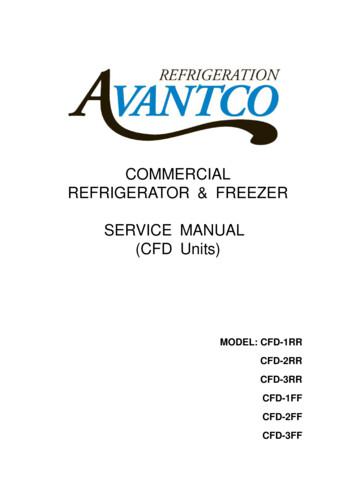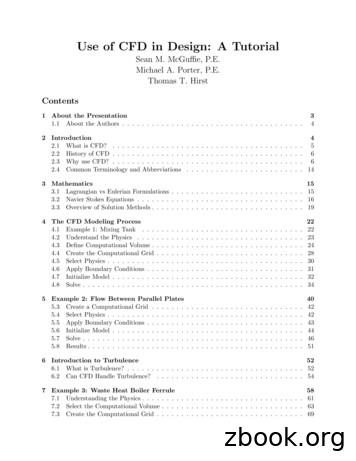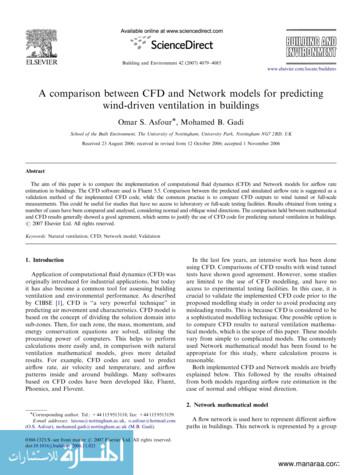CFD Analysis Of A Gasoline Engine Exhaust Pipe
urnal of ApJopeerngin inglEcd Me hanicalieISSN: 2168-9873Journal of AppliedMechanical EngineeringXu et al., J Appl Mech Eng 2016, 5:2DOI: 10.4172/2168-9873.1000198ResearchArticleResearch ArticleOpenOpenAccessAccessCFD Analysis of a Gasoline Engine Exhaust PipePengyun Xu*, Haiyong Jiang and Xiaoshun ZhaoMechanical and Electronical Engineering College, Agriculture University of Hebei, Baoding 071001, P.R. ChinaAbstractThe exhaust pipe is an important part of gasoline engine. Its structure and performance have a direct impact onthe engine power, economy and emissions, and it is one of the key technologies of multi valve engine development.In or-der to test the theoretical design of a 1.5 L gasoline engine exhaust pipe, Solidworks Flow simulation was usedto analyze the exhaust pipe. Pressure and velocity of the position near the three-way catalytic converter and theoxygen sensor were selective analyzed. CFD Simulation results show that the internal flow is laminar flow state, andthe sensor position is reasonable. The design is reasonable, and can achieve the design goal.Keywords: Exhaust pipe; Catalytic converter; Carrier component;Fluid uniformity; CFD analysisIntroductionThe exhaust pipe is an important part of gasoline engine. Itconnects all parts of the automobile exhaust system, and prevent theleakage of waste gas. Its structure and performance have a direct impacton the engine power, economy and emissions, and it is one of the keytechnologies of multi valve engine development.Automobile exhaust pipe is a space curved surface geometry, ithas a certain difficult to manufacture, and the exhaust pipe is workedin a bad condition, and some problems will occur in the process ofproduction and use. The traditional design method of the exhaustpipe is in steady flow test stand experiments, to obtain or test shapeparameter, this method takes long time and cost. However, usingcomputer fluid analysis technology (CFD), it is convenient and intuitiveto analyze the three-dimensional model of the exhaust pipe, theanalysis process is visual, and easy to adjust the parameters, the analysisresults are intuitive, determine whether the structure meets the designrequirements quickly. In this paper, SolidWorks Flow Simulation isused to simulate the structure of a certain type of engine. Pressure andvelocity of the position near the three way catalytic convert-er and theoxygen sensor were selective analyzed. The design goals are verified bysimulation analysis (CFD) results.In order to reduce the concentration of CO, NOx and CxHy inthe exhaust gas, there are (mostly) two catalytic converters installed inthe exhaust pipe system. The crucial quantity to control the efficiencyof a catalytic converter is the temperature in the catalytic converter.Due to this reason, one is interested in how to ensure a sufficienthigh temperature in the catalytic converters in a short time after theengine start. A special method of heating after the engine start is thecombustion of unburnt gas in the catalytic converters. Modern carscan control the ratio of oxygen and fuel in the combustion chamberof the engine. By choosing a ratio with more fuel and less oxygen someunburnt fuel gets to the catalytic converters and can be used there foran exothermic reaction.In order to test the theoretical design of a 1.5 L gasoline engineexhaust pipe, carrying out a natural experiment in respect gas flowhydrodynamics. To estimate the spectrum of possible technologicalinnovations in the existing struc-ture expedient, first carry out numericalsimulations using fluid dynamics software packages solidworks flowsimula-tion. This paper presents the numerical simulation of classicalstructure of exhaust pipe; the results are compared with the calculationfor the case of a conical nozzle on the exhaust pipe [1-5].J Appl Mech EngISSN:2168-9873 JAME, an open access journalMaterial and MethodsThe calculation was carried out in gas dynamics software packageSolidworks Cosmos FloWorks, which uses a finite volume method, themovement of the fluid is modeled by the Navier Stokes equations, theReynolds averaged. Their closures are used for the transport equationand its kinetic energy dissipation within the k-ε turbulence model.During the calculation was the condition of the grid and theiterative convergence, which were determined by the self-similarity ofthe final result of the number of cells and iterations.Calculation of the motion of particles in the flow was conductedunder the following assumptions: Uniform air and standard atmospheric pressure; The particles have a spherical shape; The drag coefficient of the particle is calculated by Henderson’sequation;A series of pertinent indoor and outdoor experiments arecarried out to know the engineering properties of exhaust pipe, andprovide theoretical references for engineering quality evaluation andimprovement scheme selection.3-D model analysis of exhaust pipeUsing SolidWorks software to establish the 3D model of the exhaustpipe, as shown in Figure 1. The model parameters are shown in Table 1.In order to control the automobile harmful gases such as NOx,HC and CO, the three-way catalytic converter must be installed inthe exhaust pipe. The harmful gases can be converted into harmlesscarbon dioxide, water and nitrogen by oxidizing and reducing gases.The carrier component of the three-way catalytic converter is a porousceramic material, which is installed in the specific position of the*Corresponding author: Pengyun Xu, Mechanical and Electronical EngineeringCollege, Agriculture University of Hebei, Baoding 071001, PR China, Tel: 86-03127526455; E-mail: pengyun99@qq.comReceived January 07, 2016; Accepted February 16, 2016; Published February19, 2016Citation: Xu P, Jiang H, Zhao X (2016) CFD Analysis of a Gasoline Engine ExhaustPipe. J Appl Mech Eng 5:198. doi:10.4172/2168-9873.1000198Copyright: 2016 Xu P, et al. This is an open-access article distributed under theterms of the Creative Commons Attribution License, which permits unrestricteduse, distribution, and reproduction in any medium, provided the original author andsource are credited.Volume 5 Issue 2 1000198
Citation: Xu P, Jiang H, Zhao X (2016) CFD Analysis of a Gasoline Engine Exhaust Pipe. J Appl Mech Eng 5:198. doi:10.4172/2168-9873.1000198Page 2 of 7exhaust pipe, and is the most important equipment in the automobileex-haust system. The three-way catalytic converter and oxygen sensorare generally installed in the exhaust manifold (natural gas engine)or after the turbocharger (turbocharged gasoline engine). The vectorparameters and grid partition are shown in Tables 2 and 3. Gridpartitioning result is shown in Figure 2.Boundary conditions settingFluid computational domain is shown in Figure 3. Boundaryconditions are shown in Table 4. The velocity in the inlet section was setas a fully developed turbulent flow in a pipe, its mean value of 0.13 kg/s;in the outlet section was set at ambient pressure 101325 Pa; on the wallsof all the components of the velocity zeroed (condition “sticking”) [69].1. Import, 2. oxygen sensor (Pre), 3. Pre-catalytic converter, 4. Main catalyticConverter, 5. oxygen sensor(Main), 6. exportFigure 2: Grid partitioning results.Additional information:(a) fixed wall boundaryAdiabatic slip free, fixed temperature wall 293 K, the boundarylayer is treated by turbulent wall law.(b) import and export boundaryUse the parameters in steady flow test, the values shown in Table 4.Analysis targetThe inhomogeneous flow of the front end face of the catalyticconverter can produce the phenomenon of vortex flow and airseparation, which cause the temperature distribution no uniform,also cause the carrier component damage, and then affect the engine’sFigure 3: Fluid computational domain.ParameterSettingImportFlow 0.13 kg/s temperature 85 ExportRelative pressure 30 KPaWallNo slipPre-catalytic converterPorosity 0.81Main catalytic converterPorosity 0.75Table 4: Import and export boundary parameters.work. Therefore, it is necessary to analyze the flow uniformity index γ,the range is between 0 1, and the 1 means completely uniform. Whenγ is more than 0.9, the flow uniformity of the cross section is better.Figure 1: 3-D model of the exhaust pipe.Grid type gridGrid numberTetrahedral mesh and prismatic boundary layer grid692162Table 1: Shape parameter 690Main catalyticconverter4006130101.6152.4Table 2: The carrier component parameters.NameDataPre-catalytic converter inlet pipe diameter62Pre-catalytic converter length90Main catalytic converter inlet pipe diameter62Main catalytic converter length152.4Total length2150Table 3: Grid partition.J Appl Mech EngISSN:2168-9873 JAME, an open access journalIf the position of the oxygen sensor in the exhaust pipe is notsuitable, the oxygen sensor cannot measure the oxygen concentrationaccurately [10-15]. It will affect the air fuel ratio of the ECU calibration,and directly affect the engine’s power per-formance and emissionperformance. So it is necessary to use CFD to analyze the flow fieldaround the exhaust pipe.The CFD analysis process is shown in Figure 4.Results and DiscussionThe computed result of all design variables were analysed anddiscussed in detail to identify the optimum performance of exhaustpipe. The computed result obtained at different design variables; effectsof one design variable on other variables were assessed. Effects of flowrate, pressure, uniformity index were discussed in detail [16].Flow field analysisThe whole pressure field shows that the fluid pressure decreasesalong the axis of the tube, and the pressure gradi-ent is obvious in theposition of the expanding port and the shrink port. The result is shownas Figure 5.Volume 5 Issue 2 1000198
Citation: Xu P, Jiang H, Zhao X (2016) CFD Analysis of a Gasoline Engine Exhaust Pipe. J Appl Mech Eng 5:198. doi:10.4172/2168-9873.1000198Page 3 of 7Figure 4: CFD analysis process.Figure 5: Pressure field analysis.J Appl Mech EngISSN:2168-9873 JAME, an open access journalVolume 5 Issue 2 1000198
Citation: Xu P, Jiang H, Zhao X (2016) CFD Analysis of a Gasoline Engine Exhaust Pipe. J Appl Mech Eng 5:198. doi:10.4172/2168-9873.1000198Page 4 of 7Pressure field distributionOxygen sensor position CFD analysisAs shown in Figure 6, near the inlet elbow outside wall, the radialpressure of pre-catalytic converter carrier component is relativelylarge. Near axis center, the axial pressure of main- catalytic convertercarrier component is relatively large [17].The front oxygen sensor is located in the main flow area, which isin accordance with the design requirements; The rear oxygen sensor islocated in the main flow area, which is in accordance with the designrequirements. The analysis result is shown as Figure 10.Pressure drop analysisFluid uniformity analysisThe main pressure drop detection position of the air flow in thepipe is shown in Figure 7, and the pressure loss value is shown in Table5.In general, the calculation of the fluid uniformity coefficient γ isonly for the end face of catalytic converter. When γ 0.9, it is necessaryto optimize the import.Velocity field analysisAfter calculation, the fluid uniformity coefficient γ of the maincatalytic converter end face is 0.97, and the precatalytic converter is0.696. The results are shown in Figure 11.The Figure 8 shows that when the inlet flow is 0.13 kg/s, the highestflow rate can reach 104.8 m/s, and the velocity muta-tion mainlyoccurred in the import (export) conical surface. Fluid through thecatalytic converter, Reynolds number Re 2000, is laminar flow state.As is shown in Figure 9, the maximum speed of the pre-catalyticconverter end face is 34.92 m/s, the maximum speed of the maincatalytic converter end face is 48.91 m/s, which is less than 100 m/s,that is in accordance with the design requirements.Velocity Index is a criterion for judging the radial force of the carriercomponent, as shown in Figure 12, the calculation method is shown informula (1 3). Under normal circumstances, when the velocity indexε 0.7, that is in accordance with design requirements, but when thefluid uniformity γ 0.94, without considering the influence of VelocityIndex [18].Figure 6: Pressure field distribution.Figure 7: Pressure drop detection position.J Appl Mech EngISSN:2168-9873 JAME, an open access journalVolume 5 Issue 2 1000198
Citation: Xu P, Jiang H, Zhao X (2016) CFD Analysis of a Gasoline Engine Exhaust Pipe. J Appl Mech Eng 5:198. doi:10.4172/2168-9873.1000198Page 5 of 7PositionPressure drop data (KPa)P112.57P29.09P321.65Table 5: Pressure drop.Figure 8: Velocity field analysis.Figure 9: Section of velocity distribution.J Appl Mech EngISSN:2168-9873 JAME, an open access journalVolume 5 Issue 2 1000198
Citation: Xu P, Jiang H, Zhao X (2016) CFD Analysis of a Gasoline Engine Exhaust Pipe. J Appl Mech Eng 5:198. doi:10.4172/2168-9873.1000198Page 6 of 7Figure 10: Oxygen sensor position CFD analysis (pre & main).Figure 11: Fluid uniformity analysis.Figure 12: Velocity index.J Appl Mech EngISSN:2168-9873 JAME, an open access journalVolume 5 Issue 2 1000198
Citation: Xu P, Jiang H, Zhao X (2016) CFD Analysis of a Gasoline Engine Exhaust Pipe. J Appl Mech Eng 5:198. doi:10.4172/2168-9873.1000198Page 7 of 7ParameterPre-catalytic converterMain catalytic converterXv, max408.358137.256Xv, mid392.497120.36Yv, max-109.333209.776Yv, mid-134.719171.64L101.6101.6ε0.5890.821The authors thank the Science research project of Hebei Province, YouthScience and Technology Fund of agriculture university of Hebei, and Baodingscience and technology research and development plan for support.References1. Tao J, Maji L (2012) CFD automatic analysis process of the engine ports.Journal of Wuhan University of Technology 34: 310-312.2. Zhi W, Ronghua H (2002) Research based on CAD/CAM/ CFD for engine portdevelopment. Chinese Internal Combustion Engine Engineering 23: 26-29.Table 6: Velocity index calculation results.ParameterPre-catalyticconverterMain catalyticconverterTotal21.65Pressure drop (KPa)12.579.09Fluid uniformity coeffi-cient γ0.6960.97velocity index ε0.5890.821The maximum speed34.9248.913. Kharkov N, Vatin N, Strelets K (2014) Gas dynamics in a counter-flow cyclonewith conical nozzles on the exhaust pipe. Applied Mechanics & Materials: 635637.4. Gasser I, Rybicki M (2013) Modelling and simulation of gas dynamics in anexhaust pipe. Applied Mathematical Modelling 37: 2747-2764.5. Usmanova RR, Zaikov GE, Stoyanov OV, Klodzinska E (2013) Research of themechanism of shock-interial deposition of dits-persed particles from gas flow.Herald of Kazan Technological University 16: 203-207.Table 7: Results of comprehensive analysis.εx εy ε2( xv,max xmid )Lmajor2( yv,max ymid )Lminorε x2 ε y2Acknowledgement(1)6. Usmanova RR, Zaikov GE (2014) The new equipment for modernization ofsystem of clearing of flue gases Herald of Kazan Technological University 17:246-251.(2)7. Usmanova RR, Zaikov GE (2014) Experimental researches and calculation ofboundary concentration of an irrigating liquid. Herald of Kazan TechnologicalUniversity 17: 183-187.(3)Velocity Index calculation results are shown in Table 6.The velocity index ε of the precatalytic converter is 0.589, whichis less than 0.7, means that is in accordance with design requirements.Even if the main catalytic converter velocity index ε (0.821) is morethan 0.7, but also in accordance with design requirements, because themain catalytic converter fluid uniformity coefficient γ 0.97, is morethan 0.94.The comprehensive analysis of the exhaust pipe is shown in Table 7.ConclusionTake integrated analysis of the above test results, and the followingconclusions can be drawn:(1) The exhaust pipe pressure loss of the catalytic converters is12.57 kPa, 9.09 kPa, 21.65 kPa, which is in accordance with thedesign requirements.8. Usmanova RR, Zaikov GE, Zaikov VG (2008) Calculation of dust separationefficiency of new dising dynamic gas washer. Journal of the Balkan TribologicalAssociation 14: 247-251.9. Panov AK, Usmanova RR, Zaikov VG, Zaikov GE (2007) Complex aerohydrodynamic research and the effectiveness or arresting dispersed particlesfor barbotage rotation. Journal of Applied Polymer Science 104: 2088-2091.10. Vatin NI, Chechevickin VN, Chechevickin AV (2011) About sorp-tion-catalyticair cleaning in premises for people habitation in megapolises. Magazine of CivilEngineering 1: 24-27.11. Wangwenhai W, Cho HM (2014) A Study on the Fluid Dynamic of CatalyticConverter in Exhaust Pipe”, Journal of Energy Engi-neering 23: 114-118.12. Kumar S, Bergada JM (2013)The effect of piston grooves performance inan axial piston pumps via CFD analysis. International Journal of MechanicalSciences 66: 168-179.13. Omidbeygi F, Hashemabadi SH (2013) Exact solution and CFD simulation ofmagnetorheological fluid purely tangential flow within an eccentric annulus.International Journal of Mechanical Sciences 75: 26-33.14. Li J, Uttarwar RG, Huang Y (2013) CFD-based modeling and design forenergy-efficient VOC emission reduction in surface coat-ing systems. CleanTechnologies and Environmental Policy 15: 1023-1032.(2) The fluid uniformity coefficient of the inlet end face of thecatalytic converter is satisfied.15. Chica Arrieta EL, Florez SA, Sierra NI (2013) Application of CFD to the designof the runner of a propeller turbine for small hydroelectric power plants. RevFac Ing Univ Antioquia: 181-192.(3) The velocity index of the main and the pre catalytic convertermeets the design requirements.16. Mitiku Y, Ramayya V, Shunki G (2015) Turbine Driven Pump CFD Modellingand Simulation a Centrifugal Pump Optimization forIrrigation. InternationalJournal of Engineering and Technical Research (IJETR) 3: 154-159.(4) The maximum flow velocity of the pre and main catalyticconverter is less than 100 m/s, which meets the designrequirements.(5) The flow velocity of the oxygen sensor is higher and the oxygensensor place is more reasonable.J Appl Mech EngISSN:2168-9873 JAME, an open access journal17. Ramos HM, Simao M, Borga A (2012) CFD and experimental study in theoptimization of an energy converter for low heads. CSCanada. Energy Scienceand Technology 4: 1029-1035.18. Nawaz H, Yuan YS (2013) Thermal Comfort Analysis of a Ship Air-ConditioningSystem Using Solidworks Flow Simulation. Advanced Materials Research 4:883-888.Volume 5 Issue 2 1000198
l i e d M ech a n i c a l E n g n e e i n g ISSN: 2168-9873 olue ssue 10001 Al Mech Eng 17 AME, an oen access ournal CFD Analysis of a Gasoline Engine Exhaust Pipe Pengyun Xu*, Haiyong Jiang and Xiaoshun Zhao Mechanical and Electronical Engineering College, Ag
refrigerator & freezer . service manual (cfd units) model: cfd-1rr . cfd-2rr . cfd-3rr . cfd-1ff . cfd-2ff . cfd-3ff . 1 table of contents
430 allocation to elianto cfd o&m 20,577.32 440 allocation to trillium west cfd o&m 27,267.00 450 allocation to west park cfd o&m 70,008.22 460 allocation to festival ranch cfd o&m 177,790.54 480 allocation to tartesso west cfd o&m 27,809.17 481 allocation to anthem sun valley cfd o&
A.2 Initial Interactive CFD Analysis Figure 2: Initial CFD. Our forward trained network provides a spatial CFD analysis prediction within a few seconds and is visualised in our CAD software. A.3 Thresholded and Modified CFD Analysis Figure 3: Threshold. The CFD is thresholded to localise on
TCEQ, Emission Inventory of Bulk Gasoline Terminals and Bulk Gasoline Plants Final, August 15, 2013 4 consumer's motor vehicle gasoline tank delivered at retail gasoline stations. For purposes of this inventory, only those evaporative losses that occur within the bulk terminal or bulk plant fence
CFD Analysis Process 1. Formulate the Flow Problem 2. Model the Geometry 3. Model the Flow (Computational) Domain 4. Generate the Grid 5. Specify the Boundary Conditions 6. Specify the Initial Conditions 7. Set up the CFD Simulation 8. Conduct the CFD Simulation 9. Examine and Process the CFD Results 10. F
performing CFD for the past 16 years and is familiar with most commercial CFD packages. Sean is the lead author for the tutorial and is responsible for the following sections: General Procedures for CFD Analyses Modeling Turbulence Example 3 - CFD Analysis
The CFD software used i s Fluent 5.5. Comparison between the predicted and simulated airflow rate is suggested as a validation method of the implemented CFD code, while the common practice is to compare CFD outputs to wind tunnel or full-scale . Both implemented CFD and Network models are briefly explained below. This followed by the .
Emphasis is on comparing CFD results, not comparison to experiment CFD Solvers: BCFD, CFD , GGNS Grids: JAXA (D), ANSA (E), VGRID (C) Turbulence Models: Spalart-Allmaras (SA), SA-QCR, SA-RC-QCR Principal results: Different CFD codes on same/similar meshes with same turbulence model generate similar results























